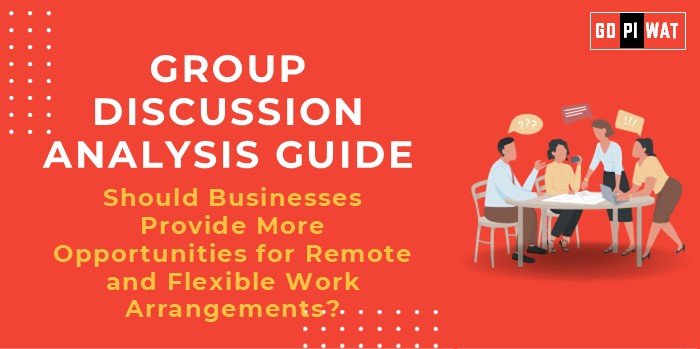📋 Group Discussion Analysis Guide: Should Businesses Provide More Opportunities for Remote and Flexible Work Arrangements?
🌐 Introduction to Remote and Flexible Work
- 💡 Opening Context: The global shift towards remote and flexible work has accelerated, especially since the COVID-19 pandemic, redefining how businesses operate, balance productivity, and attract top talent.
- 📖 Topic Background: While flexible work began as an experiment, companies worldwide now see it as a strategic tool to improve employee satisfaction, reduce operational costs, and access a broader talent pool.
📊 Quick Facts and Key Statistics
- 🌍 Global Workforce Trends: 50% of knowledge workers globally are remote or hybrid as of 2023.
- 📈 Productivity: 77% of remote employees report higher productivity when working from home (Gartner, 2023).
- 👩💻 Talent Attraction: 70% of employees view flexible work as a key factor in job selection (McKinsey Report).
- 💰 Cost Savings: Companies save an average of $11,000 per remote employee annually (Global Workplace Analytics).
🤝 Stakeholders and Their Roles
- 🏢 Businesses: Decision-makers assessing productivity, employee engagement, and cost benefits of flexible work models.
- 👨💼 Employees: Workers balancing work-life integration and expecting flexibility to boost morale and performance.
- 🏛️ Governments: Policymakers shaping labor laws to regulate remote work rights and employee protections.
- 💻 Tech Companies: Providers of virtual tools like Zoom, Slack, and cloud systems that enable remote collaboration.
🏆 Achievements and Challenges
✨ Achievements:
- 📈 Increased Productivity: Studies show remote work reduces office distractions, boosting focus.
- 💰 Cost Efficiency: Lower operational costs for businesses (rent, utilities) and reduced commute costs for employees.
- 🌍 Talent Diversification: Businesses access skilled workers across geographic boundaries.
- 🌱 Environmental Benefits: Remote work reduces carbon footprints due to fewer commutes.
⚠️ Challenges:
- 😓 Work-Life Imbalance: Blurred boundaries between work and personal life may lead to burnout.
- 🔄 Employee Engagement: Lack of face-to-face interaction can reduce collaboration and team cohesion.
- 🌐 Digital Divide: Inconsistent internet access and technology adoption across regions.
🌍 Global Comparisons:
- 🇺🇸 USA: Companies like Google and Twitter successfully adopted hybrid work models post-pandemic.
- 🇩🇪 Germany: Legal frameworks ensure employees have a right to disconnect outside working hours.
📚 Case Study:
- 🏢 Tata Consultancy Services (TCS): Shifted 75% of its workforce to permanent remote models by 2025, projecting enhanced agility and reduced costs.
🗣️ Structured Arguments for Discussion
- ✅ Supporting Stance: “Remote work promotes higher productivity, lowers costs, and enables work-life balance, benefiting both employers and employees.”
- ❌ Opposing Stance: “Flexible work creates challenges in employee engagement, team synergy, and organizational culture.”
- ⚖️ Balanced Perspective: “While remote work boosts productivity and efficiency, it must be balanced with policies ensuring engagement and mental well-being.”
💡 Effective Discussion Approaches
📜 Opening Approaches:
- “According to Gartner, 77% of remote employees report higher productivity, challenging traditional office setups.”
- “Companies like TCS and Google are reshaping business models to embrace flexible work policies.”
🔍 Counter-Argument Handling:
- Challenge: “Remote work reduces collaboration.”
Rebuttal: “Tools like Slack, Zoom, and Microsoft Teams foster real-time collaboration and communication globally.”
📈 Strategic Analysis of Strengths and Weaknesses
- 🏅 Strengths: Higher productivity, lower costs, talent mobility.
- ⚠️ Weaknesses: Employee isolation, digital inequalities, cultural gaps.
- 💡 Opportunities: Innovative collaboration tools, global talent recruitment.
- ⚡ Threats: Cybersecurity risks, reduced employee loyalty.
🎓 Connecting with B-School Applications
- 📚 Real-World Applications: Analyzing remote work’s impact on business strategy, operations, and employee well-being.
- 💬 Sample Interview Questions:
- “How can companies balance productivity with employee engagement in remote work models?”
- “Evaluate the economic impact of flexible work on businesses and employees.”
- 🔑 Insights for B-School Students:
- Remote work can inspire innovative HR solutions, workforce management tools, and operational cost reductions.


